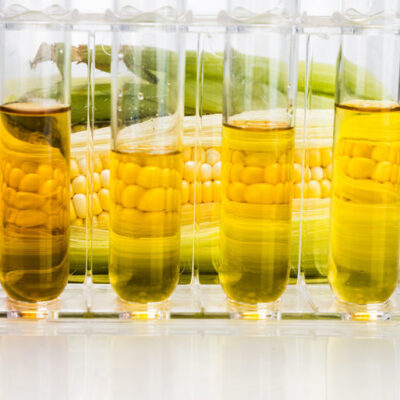Origin
HFCS was first developed in 1957, by two biochemists Marshall and Kooi. They discovered an enzyme capable of isomerizing dextrose to fructose.2 The process of producing it efficiently and economically was introduced about 20 years later by Dr. Yoshiyuki Takasaki in Japan. By the mid 1980s, HFCS became the sweetener of choice in the United States.
Function2
In baked products HFCS performs several functions including:
- Sweetening: HFCS has a higher sweetness perception than sucrose due to its fructose content. Its sweetness release is rapid with no lingering, a desirable attribute for enhancing fruits flavors, spiciness and tartness. 2,3
- Moisture retention: moisture retention of HFCS and its humectant properties exceed those of sucrose. Subsequently, HFCS prolongs shelf life of baked goods by retarding staling and microbial growth.
- Browning: the high concentration of reducing sugars in HFCS allows its participation in non enzymatic Maillard reactions reflected in enhanced crust color of breads and rolls.
- Stability: in acidic food systems HFCS does not invert like sucrose, thus the flavor profile remains the same during storage.
- Other physical properties: By virtue of its high solid content, HFCS can influence the freezing point, scoopability and dispersing of ice creams. The resulting product is softer than its sucrose counterpart.3
Composition2
| Components | 42 % HFCS | 55 % HFCS | 90 % HFCS |
|---|---|---|---|
| Fructose* | 42 % | 55 % | 90 % |
| Dextrose* | 52 % | 41 % | 8 % |
| Higher saccharides* | 6 % | 4 % | 2 % |
| Dry solids | 71 % | 77 % | 77 % |
| Moisture | 29 % | 23 % | 23 % |
*Dry solids basis
Nutrition
HFCS has the same caloric value as typical carbohydrates i.e. 4 kcal/g. Its glycemic index (GI) is similar to that of sucrose and honey whose average values are 55 and 68, respectively.2
Commercial production2
High fructose corn syrup is industrially obtained through the following process:
- Corn wet milling to separate starch from other parts of the corn kernel and formation of a slurry.
- Liquefaction of starch slurry by alpha amylase at 180-200 °F (82-93°C) in a reactor to a dextrose equivalent (DE) of 10-20.4
- Conversion of liquefied starch by glucoamylase at 130-140°F (55-60°C) to a dextrose syrup with up to 95% dextrose content.4
- Filtration and decolorization with an activated carbon filter followed by salts and ionic compounds removal using ion exchange membrane.
- Isomerization with glucose isomerase in a fixed-bed column to convert glucose into fructose, up to 45% fructose.
- Filtering and refining with activated carbon and ion exchange membranes.
- Evaporation of the syrup to a concentration of 42% fructose. Higher concentrations can be obtained through fractionation to enrich the isomerized glucose syrup and produce HFCS with 55 and 90% fructose.
Application
As a sweetener, HFCS is traditionally used in carbonated drinks.1 In baking applications, HFCS acts as a fermentable sugar, a sweetener and humectant. In breads, buns, rolls and yeast raised donuts, it ferments directly without the need for sugar inversion.2
In ice cream and other dairy products such as chocolate milk, HFCS is effective in enhancing their textural and sparsity properties, especially in chocolate milk.2
FDA regulations
HFCS is considered GRAS by the FDA. The 2010 Dietary Guidelines for Americans recommends limiting their consumption of all added sugars including HFCS.5
References
- Figoni, P. How Baking Works: Exploring The Fundamentals Of Baking Science. 2nd ed., John Wiley & Sons, Inc., 2008, pp. 237-257.
- O’Brien,L. Alternative Sweeteners. 4th ed., Taylor & Francis Group, LLC, 2012, pp. 403-420.
- Rippe, J. M. Fructose, High Fructose Corn Syrup, Sucrose And Health. 1st ed., Springer New York, 2014, pp. 25-27.
- BeMiller, J N, and Whistler, R.L. Starch: Chemistry And Technology. 3rd ed., Elsevier Academic Press, 2009, pp. 808-813.
- Food and Drug Administration. “High Fructose Corn Syrup Questions and Answers”.Food Additives and Petitions, 04 Jan 2018. https://www.fda.gov/food/food-additives-petitions/high-fructose-corn-syrup-questions-and-answers.Accessed 19 Mar 2020.

